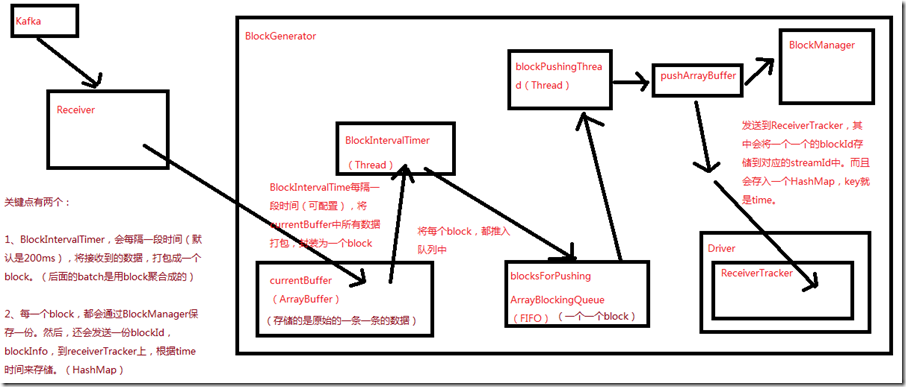65、Spark Streaming:数据接收原理剖析与源码分析
一、数据接收原理

二、源码分析
入口包org.apache.spark.streaming.receiver下ReceiverSupervisorImpl类的onStart()方法
###
override protected def onStart() {
// 这里的blockGenerator很重要,和数据接收有关,其运行在worker的executor端负责数据接收后的一些存取工作,以及配合ReceiverTracker
// 在Executor上,启动Receiver之前,就会先启动这个Receiver相关的一个blockGenerator,该组件,在数据接收中,极其重要
blockGenerator.start()
}
ReceiverSupervisorImpl类的onStart()方法,调用了blockGenerator.start()方法,跟进去看看
###org.apache.spark.streaming.receiver/BlockGenerator.scala
def start() {
// BlockGenerator.start()方法,其实就是启动内部两个关键的后台线程,
// 一个是blockIntervalTimer,负责将currentBuffer中的原始数据,打包成一个个的block
// 另一个是blockPushingThread,负责将blocksForPushing中的block,调用pushArrayBuffer()方法
blockIntervalTimer.start()
blockPushingThread.start()
logInfo("Started BlockGenerator")
}
blockGenerator.start()方法,调用了blockIntervalTimer.start()和blockPushingThread.start()方法
先看看有关变量的定义
###org.apache.spark.streaming.receiver/BlockGenerator.scala
private val blockInterval = conf.getLong("spark.streaming.blockInterval", 200)
// blockInterval,是有一个默认值的,spark.streaming.blockInterval,默认是200ms,每隔200ms,就会调用updateCurrentBuffer函数
private val blockIntervalTimer =
new RecurringTimer(clock, blockInterval, updateCurrentBuffer, "BlockGenerator")
// blocksForPushing队列的长度,可以调节的,spark.streaming.blockQueueSize,默认10个,可大可小
private val blockQueueSize = conf.getInt("spark.streaming.blockQueueSize", 10)
// blocksForPushing队列,
private val blocksForPushing = new ArrayBlockingQueue[Block](blockQueueSize)
// blockPushingThread,后台线程,启动之后,就会调用keepPushingBlocks()方法,这个方法中,就会每隔一段时间,去blocksForPushing队列中取block
private val blockPushingThread = new Thread() { override def run() { keepPushingBlocks() } }
// 这个currentBuffer,就是用于存放原始的数据
@volatile private var currentBuffer = new ArrayBuffer[Any]
blockIntervalTimer.start()就是一个线程,这个方法就不看了
重点看下blockPushingThread.start()方法,这个线程开始运行,会调用keepPushingBlocks()方法,代码如下
###org.apache.spark.streaming.receiver/BlockGenerator.scala
private val blockPushingThread = new Thread() { override def run() { keepPushingBlocks() } }
看keepPushingBlocks()方法
###org.apache.spark.streaming.receiver/BlockGenerator.scala
private def keepPushingBlocks() {
logInfo("Started block pushing thread")
try {
while(!stopped) {
// 从blocksForPushing这个队列中,poll出来当前队列队首的block,对于阻塞队列,默认设置100ms的超时
Option(blocksForPushing.poll(100, TimeUnit.MILLISECONDS)) match {
// 如果拿到了block,调用pushBlock去推送block
case Some(block) => pushBlock(block)
case None =>
}
}
// Push out the blocks that are still left
logInfo("Pushing out the last " + blocksForPushing.size() + " blocks")
while (!blocksForPushing.isEmpty) {
logDebug("Getting block ")
val block = blocksForPushing.take()
pushBlock(block)
logInfo("Blocks left to push " + blocksForPushing.size())
}
logInfo("Stopped block pushing thread")
} catch {
case ie: InterruptedException =>
logInfo("Block pushing thread was interrupted")
case e: Exception =>
reportError("Error in block pushing thread", e)
}
}
可以看到keepPushingBlocks()方法,如果拿到了block,调用pushBlock()方法
看看pushBlock()方法
###org.apache.spark.streaming.receiver/BlockGenerator.scala
private def pushBlock(block: Block) {
listener.onPushBlock(block.id, block.buffer)
logInfo("Pushed block " + block.id)
}
pushBlock()方法会调用listener.onPushBlock()方法,这个listener是BlockGeneratorListener,onPushBlock()在ReceiverSupervisorImpl类中,
看ReceiverSupervisorImpl类的onPushBlock()方法:
###org.apache.spark.streaming.receiver/ReceiverSupervisorImpl.scala
// onPushBlock就会去调用pushArrayBuffer去推送block
def onPushBlock(blockId: StreamBlockId, arrayBuffer: ArrayBuffer[_]) {
pushArrayBuffer(arrayBuffer, None, Some(blockId))
}
onPushBlock就会去调用pushArrayBuffer()方法
看pushArrayBuffer()方法:
###org.apache.spark.streaming.receiver/ReceiverSupervisorImpl.scala def pushArrayBuffer(
arrayBuffer: ArrayBuffer[_],
metadataOption: Option[Any],
blockIdOption: Option[StreamBlockId]
) {
pushAndReportBlock(ArrayBufferBlock(arrayBuffer), metadataOption, blockIdOption)
}
接着看pushAndReportBlock()方法:
###org.apache.spark.streaming.receiver/ReceiverSupervisorImpl.scala def pushAndReportBlock(
receivedBlock: ReceivedBlock,
metadataOption: Option[Any],
blockIdOption: Option[StreamBlockId]
) {
val blockId = blockIdOption.getOrElse(nextBlockId)
val numRecords = receivedBlock match {
case ArrayBufferBlock(arrayBuffer) => arrayBuffer.size
case _ => -1
} val time = System.currentTimeMillis
// 还用receivedBlockHandler,去调用storeBlock方法,存储block到BlockManager中,这里,也可以看出预写日志的机制
val blockStoreResult = receivedBlockHandler.storeBlock(blockId, receivedBlock)
logDebug(s"Pushed block $blockId in ${(System.currentTimeMillis - time)} ms") // 封装一个ReceiverBlockInfo对象,里面有一个streamId
val blockInfo = ReceivedBlockInfo(streamId, numRecords, blockStoreResult)
// 调用了ReceiverTracker的Acrot的ask方法,发送AddBlock消息
val future = trackerActor.ask(AddBlock(blockInfo))(askTimeout)
Await.result(future, askTimeout)
logDebug(s"Reported block $blockId")
}
这里主要看receivedBlockHandler.storeBlock()方法和trackerActor.ask(AddBlock(blockInfo))(askTimeout)
首先看receivedBlockHandler.storeBlock(),看看receivedBlockHandler是什么
###org.apache.spark.streaming.receiver/ReceiverSupervisorImpl.scala
private val receivedBlockHandler: ReceivedBlockHandler = {
// 如果开启了预写日志机制,spark.streaming.receiver.writeAheadLog.enable,默认false
// 如果为true,那么receivedBlockHandler就是WriteAheadLogBasedBlockHandler
// 如果没有开启预写日志机制,那么receivedBlockHandler就是BlockManagerBasedBlockHandler
if (env.conf.getBoolean("spark.streaming.receiver.writeAheadLog.enable", false)) {
if (checkpointDirOption.isEmpty) {
throw new SparkException(
"Cannot enable receiver write-ahead log without checkpoint directory set. " +
"Please use streamingContext.checkpoint() to set the checkpoint directory. " +
"See documentation for more details.")
}
new WriteAheadLogBasedBlockHandler(env.blockManager, receiver.streamId,
receiver.storageLevel, env.conf, hadoopConf, checkpointDirOption.get)
} else {
new BlockManagerBasedBlockHandler(env.blockManager, receiver.storageLevel)
}
接着分别看BlockManagerBasedBlockHandler和WriteAheadLogBasedBlockHandler的storeBlock()方法
先看WriteAheadLogBasedBlockHandler
###org.apache.spark.streaming.receiver/ReceivedBlockHandler.scala
def storeBlock(blockId: StreamBlockId, block: ReceivedBlock): ReceivedBlockStoreResult = {
// Serialize the block so that it can be inserted into both
// 先用BlockManager序列化数据
val serializedBlock = block match {
case ArrayBufferBlock(arrayBuffer) =>
blockManager.dataSerialize(blockId, arrayBuffer.iterator)
case IteratorBlock(iterator) =>
blockManager.dataSerialize(blockId, iterator)
case ByteBufferBlock(byteBuffer) =>
byteBuffer
case _ =>
throw new Exception(s"Could not push $blockId to block manager, unexpected block type")
}
// Store the block in block manager
// 将数据保存到BlockManager中去,默认的持久化策略,StorageLevel,是带_SER,_2的,会序列化,复制一份副本到其他Executor的BlockManager,以供容错
val storeInBlockManagerFuture = Future {
val putResult =
blockManager.putBytes(blockId, serializedBlock, effectiveStorageLevel, tellMaster = true)
if (!putResult.map { _._1 }.contains(blockId)) {
throw new SparkException(
s"Could not store $blockId to block manager with storage level $storageLevel")
}
}
// Store the block in write ahead log
// 将block存入预写日志,通过logManager的writeToLog()方法
val storeInWriteAheadLogFuture = Future {
logManager.writeToLog(serializedBlock)
}
// Combine the futures, wait for both to complete, and return the write ahead log segment
val combinedFuture = storeInBlockManagerFuture.zip(storeInWriteAheadLogFuture).map(_._2)
val segment = Await.result(combinedFuture, blockStoreTimeout)
WriteAheadLogBasedStoreResult(blockId, segment)
}
再看BlockManagerBasedBlockHandler
###org.apache.spark.streaming.receiver/ReceivedBlockHandler.scala // 直接将数据保存到BlockManager中,就可以了
def storeBlock(blockId: StreamBlockId, block: ReceivedBlock): ReceivedBlockStoreResult = {
val putResult: Seq[(BlockId, BlockStatus)] = block match {
case ArrayBufferBlock(arrayBuffer) =>
blockManager.putIterator(blockId, arrayBuffer.iterator, storageLevel, tellMaster = true)
case IteratorBlock(iterator) =>
blockManager.putIterator(blockId, iterator, storageLevel, tellMaster = true)
case ByteBufferBlock(byteBuffer) =>
blockManager.putBytes(blockId, byteBuffer, storageLevel, tellMaster = true)
case o =>
throw new SparkException(
s"Could not store $blockId to block manager, unexpected block type ${o.getClass.getName}")
}
if (!putResult.map { _._1 }.contains(blockId)) {
throw new SparkException(
s"Could not store $blockId to block manager with storage level $storageLevel")
}
BlockManagerBasedStoreResult(blockId)
}
接着看trackerActor.ask(AddBlock(blockInfo))(askTimeout),会发一个AddBlock消息到ReceiverTracker,进入看一下:
###org.apache.spark.streaming.scheduler/ReceiverTracker.scala
private def addBlock(receivedBlockInfo: ReceivedBlockInfo): Boolean = {
receivedBlockTracker.addBlock(receivedBlockInfo)
}
接着看receivedBlockTracker的addBlock方法,除了这个方法之外,还看receivedBlockTracker的几个重要变量,
先看方法:
###org.apache.spark.streaming.scheduler/ReceivedBlockTracker.scala
def addBlock(receivedBlockInfo: ReceivedBlockInfo): Boolean = synchronized {
try {
writeToLog(BlockAdditionEvent(receivedBlockInfo))
getReceivedBlockQueue(receivedBlockInfo.streamId) += receivedBlockInfo
logDebug(s"Stream ${receivedBlockInfo.streamId} received " +
s"block ${receivedBlockInfo.blockStoreResult.blockId}")
true
} catch {
case e: Exception =>
logError(s"Error adding block $receivedBlockInfo", e)
false
}
}
再看变量
###org.apache.spark.streaming.scheduler/ReceivedBlockTracker.scala // 封装了streamId到block的映射
private val streamIdToUnallocatedBlockQueues = new mutable.HashMap[Int, ReceivedBlockQueue]
// 封装了time到block的映射
private val timeToAllocatedBlocks = new mutable.HashMap[Time, AllocatedBlocks]
// 如果开启了预写机制机制,这还有LogManager,ReceiverTracker接收到数据时,也会判断,
// 如果开启了预写日志机制,写一份到预写日志中
private val logManagerOption = createLogManager()
65、Spark Streaming:数据接收原理剖析与源码分析的更多相关文章
- 66、Spark Streaming:数据处理原理剖析与源码分析(block与batch关系透彻解析)
一.数据处理原理剖析 每隔我们设置的batch interval 的time,就去找ReceiverTracker,将其中的,从上次划分batch的时间,到目前为止的这个batch interval ...
- 64、Spark Streaming:StreamingContext初始化与Receiver启动原理剖析与源码分析
一.StreamingContext源码分析 ###入口 org.apache.spark.streaming/StreamingContext.scala /** * 在创建和完成StreamCon ...
- 22、BlockManager原理剖析与源码分析
一.原理 1.图解 Driver上,有BlockManagerMaster,它的功能,就是负责对各个节点上的BlockManager内部管理的数据的元数据进行维护, 比如Block的增删改等操作,都会 ...
- 21、Shuffle原理剖析与源码分析
一.普通shuffle原理 1.图解 假设有一个节点上面运行了4个 ShuffleMapTask,然后这个节点上只有2个 cpu core.假如有另外一台节点,上面也运行了4个ResultTask,现 ...
- 20、Task原理剖析与源码分析
一.Task原理 1.图解 二.源码分析 1. ###org.apache.spark.executor/Executor.scala /** * 从TaskRunner开始,来看Task的运行的工作 ...
- 18、TaskScheduler原理剖析与源码分析
一.源码分析 ###入口 ###org.apache.spark.scheduler/DAGScheduler.scala // 最后,针对stage的task,创建TaskSet对象,调用taskS ...
- 23、CacheManager原理剖析与源码分析
一.图解 二.源码分析 ###org.apache.spark.rdd/RDD.scalal ###入口 final def iterator(split: Partition, context: T ...
- 19、Executor原理剖析与源码分析
一.原理图解 二.源码分析 1.Executor注册机制 worker中为Application启动的executor,实际上是启动了这个CoarseGrainedExecutorBackend进程: ...
- 16、job触发流程原理剖析与源码分析
一.以Wordcount为例来分析 1.Wordcount val lines = sc.textFile() val words = lines.flatMap(line => line.sp ...
随机推荐
- ubuntu16.04 打开chrome弹出“Enter password to unlock your login keyring”解决方法
问题如图 输入开机密码发现验证失败. 解决 命令: find ~/ -name login.keyring 查找相关文件. 命令: sudo rm -rf /home/la/.local/share/ ...
- pandas.to_datetime() 只保留【年-月-日】
Outline pandas.to_datetime() 生成的日期会默认带有 [2019-07-03 00:00:00]的分钟精度:但有时并不需要这些分钟精度: 去掉分钟精度 可以通过pandas ...
- Mybatis中使用collection进行多对多双向关联示例(含XML版与注解版)
Mybatis中使用collection进行多对多双向关联示例(含XML版与注解版) XML版本: 实体类: @Data @NoArgsConstructor public class Course ...
- Stack布局中定位的方式
//……省略无关代码…… child: new Column( children: <Widget>[ new SizedBox(height: 20.0), new Stack( ali ...
- iptables限制访问
iptables限制访问 常用命令 # 查看规则 iptables -L INPUT --line-numbers # 开放指定的端口 iptables -A INPUT -p tcp --dport ...
- pandas-06 Series和Dataframe的排序操作
pandas-06 Series和Dataframe的排序操作 对pandas中的Series和Dataframe进行排序,主要使用sort_values()和sort_index(). DataFr ...
- 手写MQ框架(二)-服务端实现
一.起航 书接上文->手写MQ框架(一)-准备启程 本着从无到有,从有到优的原则,所以计划先通过web实现功能,然后再优化改写为socket的形式. 1.关于技术选型 web框架使用了之前写的g ...
- margin 外边距合并问题
一.兄弟元素的外边距合并 效果图如下:(二者之间的间距为100px,不是150px) 二.嵌套元素的外边距合并 对于两个嵌套关系的元素,如果父元素中没有内容或者内容在子元素的后面并且没有上内边距及边框 ...
- 浏览器Notwork XHR被隐藏了
图片中红色区域内容被隐藏 解决方式,点击此处
- Doctype作用,标准模式与兼容模式的区别
<!DOCTYPE>声明位于位于HTML文档中的第一行,处于 <html> 标签之前.告知浏览器的解析器用什么文档标准解析这个文档.DOCTYPE不存在或格式不正确会导致文档以 ...
